英文文献的引用方法与格式
- 格式:doc
- 大小:61.50 KB
- 文档页数:8
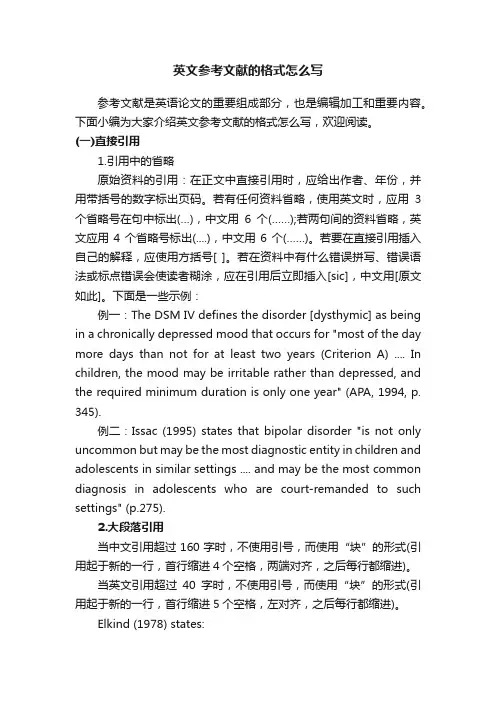
英文参考文献的格式怎么写参考文献是英语论文的重要组成部分,也是编辑加工和重要内容。
下面小编为大家介绍英文参考文献的格式怎么写,欢迎阅读。
(一)直接引用1.引用中的省略原始资料的引用:在正文中直接引用时,应给出作者、年份,并用带括号的数字标出页码。
若有任何资料省略,使用英文时,应用3个省略号在句中标出(…),中文用6个(……);若两句间的资料省略,英文应用4个省略号标出(‥‥),中文用6个(……)。
若要在直接引用插入自己的解释,应使用方括号[ ]。
若在资料中有什么错误拼写、错误语法或标点错误会使读者糊涂,应在引用后立即插入[sic],中文用[原文如此]。
下面是一些示例:例一:The DSM IV defines the disorder [dysthymic] as being in a chronically depressed mood that occurs for "most of the day more days than not for at least two years (Criterion A) .... In children, the mood may be irritable rather than depressed, and the required minimum duration is only one year" (APA, 1994, p. 345).例二:Issac (1995) states that bipolar disorder "is not only uncommon but may be the most diagnostic entity in children and adolescents in similar settings .... and may be the most common diagnosis in adolescents who are court-remanded to such settings" (p.275).2.大段落引用当中文引用超过160字时,不使用引号,而使用“块”的形式(引用起于新的一行,首行缩进4个空格,两端对齐,之后每行都缩进)。
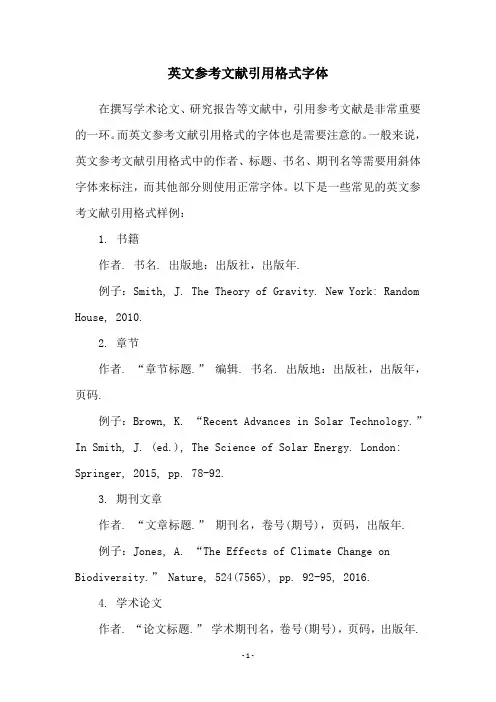
英文参考文献引用格式字体在撰写学术论文、研究报告等文献中,引用参考文献是非常重要的一环。
而英文参考文献引用格式的字体也是需要注意的。
一般来说,英文参考文献引用格式中的作者、标题、书名、期刊名等需要用斜体字体来标注,而其他部分则使用正常字体。
以下是一些常见的英文参考文献引用格式样例:1. 书籍作者. 书名. 出版地:出版社,出版年.例子:Smith, J. The Theory of Gravity. New York: Random House, 2010.2. 章节作者. “章节标题.”编辑. 书名. 出版地:出版社,出版年,页码.例子:Brown, K. “Recent Advances in Solar Technology.”In Smith, J. (ed.), The Science of Solar Energy. London: Springer, 2015, pp. 78-92.3. 期刊文章作者. “文章标题.”期刊名,卷号(期号),页码,出版年.例子:Jones, A. “The Effects of Climate Change on Biodiversity.” Nature, 524(7565), pp. 92-95, 2016.4. 学术论文作者. “论文标题.”学术期刊名,卷号(期号),页码,出版年.例子:Johnson, S. “The Role of Education in Economic Development.” Journal of Economic Education, 47(2), pp. 120-135, 2016.总之,了解英文参考文献引用格式中的字体使用规范非常重要,能够使得文献引用更加准确、规范、专业化。
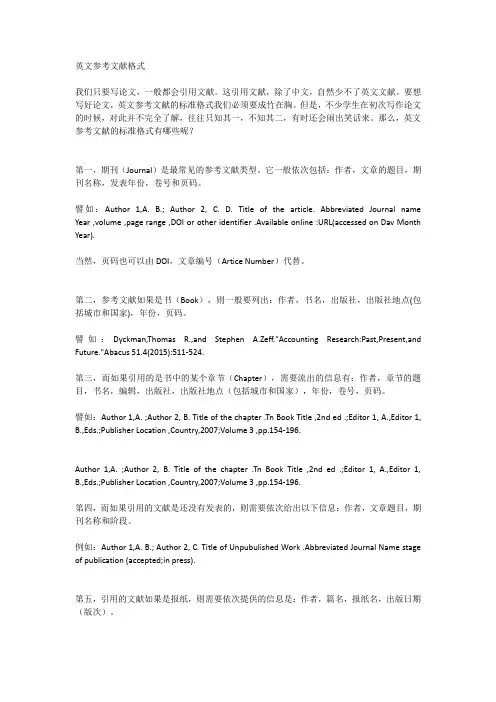
英文参考文献格式我们只要写论文,一般都会引用文献。
这引用文献,除了中文,自然少不了英文文献。
要想写好论文,英文参考文献的标准格式我们必须要成竹在胸。
但是,不少学生在初次写作论文的时候,对此并不完全了解,往往只知其一,不知其二,有时还会闹出笑话来。
那么,英文参考文献的标准格式有哪些呢?第一,期刊(Journal)是最常见的参考文献类型。
它一般依次包括:作者,文章的题目,期刊名称,发表年份,卷号和页码。
譬如:Author 1,A. B.; Author 2, C. D. Title of the article. Abbreviated Journal name Year ,volume ,page range ,DOI or other identifier .Available online :URL(accessed on Dav Month Year).当然,页码也可以由DOI,文章编号(Artice Number)代替。
第二,参考文献如果是书(Book),则一般要列出:作者,书名,出版社,出版社地点(包括城市和国家),年份,页码。
譬如:Dyckman,Thomas R.,and Stephen A.Zeff."Accounting Research:Past,Present,and Future."Abacus 51.4(2015):511-524.第三,而如果引用的是书中的某个章节(Chapter),需要流出的信息有:作者,章节的题目,书名,编辑,出版社,出版社地点(包括城市和国家),年份,卷号,页码。
譬如:Author 1,A. ;Author 2, B. Title of the chapter .Tn Book Title ,2nd ed .;Editor 1, A.,Editor 1, B.,Eds.;Publisher Location ,Country,2007;Volume 3 ,pp.154-196.Author 1,A. ;Author 2, B. Title of the chapter .Tn Book Title ,2nd ed .;Editor 1, A.,Editor 1, B.,Eds.;Publisher Location ,Country,2007;Volume 3 ,pp.154-196.第四,而如果引用的文献是还没有发表的,则需要依次给出以下信息:作者,文章题目,期刊名称和阶段。
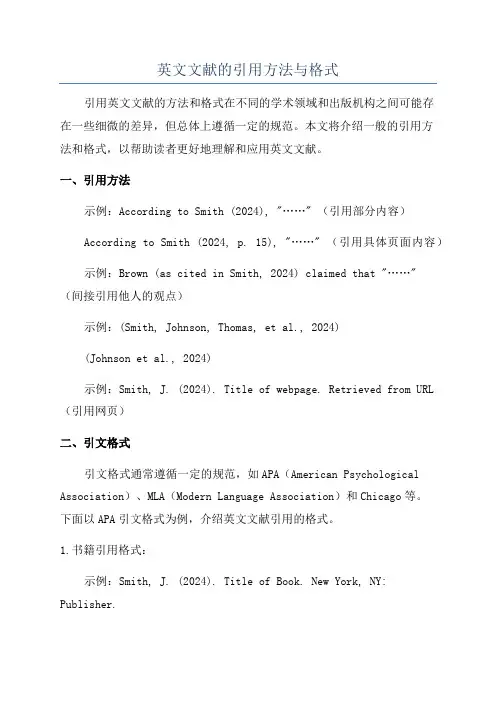
英文文献的引用方法与格式引用英文文献的方法和格式在不同的学术领域和出版机构之间可能存在一些细微的差异,但总体上遵循一定的规范。
本文将介绍一般的引用方法和格式,以帮助读者更好地理解和应用英文文献。
一、引用方法示例:According to Smith (2024), "……" (引用部分内容)According to Smith (2024, p. 15), "……" (引用具体页面内容)示例:Brown (as cited in Smith, 2024) claimed that "……"(间接引用他人的观点)示例:(Smith, Johnson, Thomas, et al., 2024)(Johnson et al., 2024)示例:Smith, J. (2024). Title of webpage. Retrieved from URL (引用网页)二、引文格式引文格式通常遵循一定的规范,如APA(American Psychological Association)、MLA(Modern Language Association)和Chicago等。
下面以APA引文格式为例,介绍英文文献引用的格式。
1.书籍引用格式:示例:Smith, J. (2024). Title of Book. New York, NY: Publisher.2.期刊文章引用格式:3.会议论文引用格式:示例:Smith, J. (2024). Title of Paper. In Proceedings of Conference Name (Vol. 1, No. 1, pp. 1-10).4.网页引用格式:示例:Smith, J. (2024). Title of Webpage. Retrieved from URL 根据具体的出版物和引文样式的要求,其中的标点符号、字体格式和字母大小写等细节可能会有所不同,建议根据目标期刊或机构的具体要求进行适当调整。
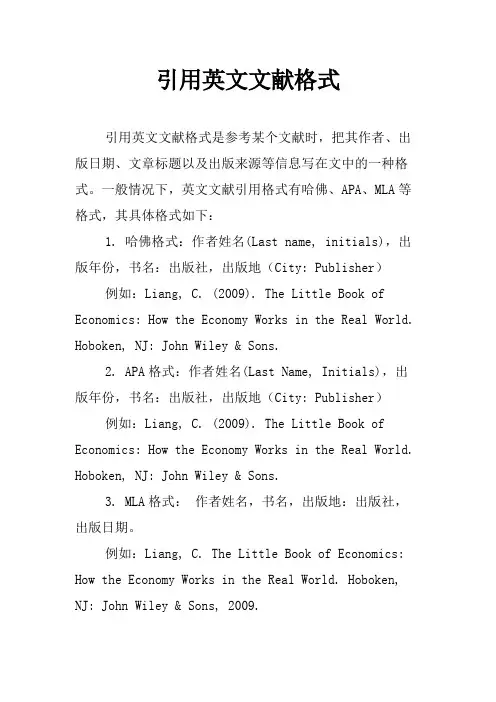
引用英文文献格式
引用英文文献格式是参考某个文献时,把其作者、出版日期、文章标题以及出版来源等信息写在文中的一种格式。
一般情况下,英文文献引用格式有哈佛、APA、MLA等格式,其具体格式如下:
1. 哈佛格式:作者姓名(Last name, initials),出版年份,书名:出版社,出版地(City: Publisher)例如:Liang, C. (2009). The Little Book of Economics: How the Economy Works in the Real World. Hoboken, NJ: John Wiley & Sons.
2. APA格式:作者姓名(Last Name, Initials),出版年份,书名:出版社,出版地(City: Publisher)例如:Liang, C. (2009). The Little Book of Economics: How the Economy Works in the Real World. Hoboken, NJ: John Wiley & Sons.
3. MLA格式:作者姓名,书名,出版地:出版社,出版日期。
例如:Liang, C. The Little Book of Economics: How the Economy Works in the Real World. Hoboken, NJ: John Wiley & Sons, 2009.。
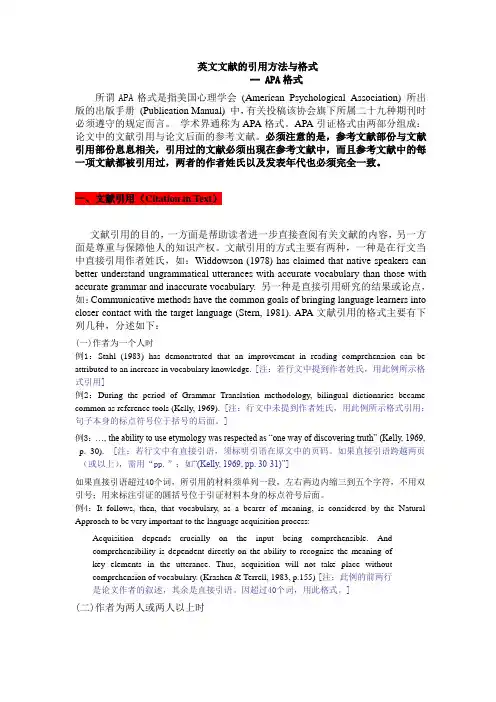
英文文献的引用方法与格式-- APA格式所谓APA格式是指美国心理学会(American Psychological Association) 所出版的出版手册(Publication Manual) 中,有关投稿该协会旗下所属二十九种期刊时必须遵守的规定而言。
学术界通称为APA格式。
APA引证格式由两部分组成:论文中的文献引用与论文后面的参考文献。
必须注意的是,参考文献部份与文献引用部份息息相关,引用过的文献必须出现在参考文献中,而且参考文献中的每一项文献都被引用过,两者的作者姓氏以及发表年代也必须完全一致。
一、文献引用(Citation in Text)文献引用的目的,一方面是帮助读者进一步直接查阅有关文献的内容,另一方面是尊重与保障他人的知识产权。
文献引用的方式主要有两种,一种是在行文当中直接引用作者姓氏,如:Widdowson (1978) has claimed that native speakers can better understand ungrammatical utterances with accurate vocabulary than those with accurate grammar and inaccurate vocabulary. 另一种是直接引用研究的结果或论点,如:Communicative methods have the common goals of bringing language learners into closer contact with the target language (Stern, 1981). APA文献引用的格式主要有下列几种,分述如下:(一)作者为一个人时例1:Stahl (1983) has demonstrated that an improvement in reading comprehension can be attributed to an increase in vocabulary knowledge.[注:若行文中提到作者姓氏,用此例所示格式引用]例2:During the period of Grammar Translation methodology, bilingual dictionaries became common as reference tools (Kelly, 1969). [注:行文中未提到作者姓氏,用此例所示格式引用;句子本身的标点符号位于括号的后面。
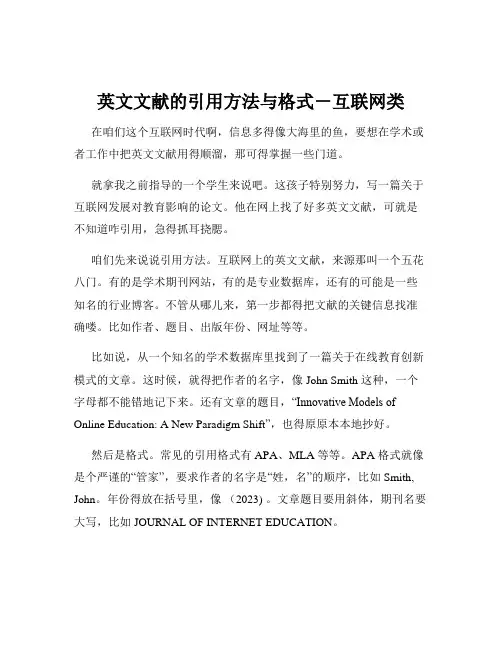
英文文献的引用方法与格式-互联网类在咱们这个互联网时代啊,信息多得像大海里的鱼,要想在学术或者工作中把英文文献用得顺溜,那可得掌握一些门道。
就拿我之前指导的一个学生来说吧。
这孩子特别努力,写一篇关于互联网发展对教育影响的论文。
他在网上找了好多英文文献,可就是不知道咋引用,急得抓耳挠腮。
咱们先来说说引用方法。
互联网上的英文文献,来源那叫一个五花八门。
有的是学术期刊网站,有的是专业数据库,还有的可能是一些知名的行业博客。
不管从哪儿来,第一步都得把文献的关键信息找准确喽。
比如作者、题目、出版年份、网址等等。
比如说,从一个知名的学术数据库里找到了一篇关于在线教育创新模式的文章。
这时候,就得把作者的名字,像 John Smith 这种,一个字母都不能错地记下来。
还有文章的题目,“Innovative Models of Online Education: A New Paradigm Shift”,也得原原本本地抄好。
然后是格式。
常见的引用格式有 APA、MLA 等等。
APA 格式就像是个严谨的“管家”,要求作者的名字是“姓,名”的顺序,比如 Smith, John。
年份得放在括号里,像(2023) 。
文章题目要用斜体,期刊名要大写,比如 JOURNAL OF INTERNET EDUCATION。
MLA 格式呢,则有点像个“文艺青年”,作者名字是“名姓”,John Smith 。
题目不用斜体,用引号括起来,比如"Innovative Models of Online Education: A New Paradigm Shift" 。
再举个例子,要是引用一个互联网博客上的观点。
得把博主的名字、文章发布的日期、博客的名字还有网址都记清楚。
比如说,博主叫Mary Doe ,文章是 2022 年 5 月 10 号发的,博客叫“Tech Insights”,网址是/article/123 。
引用的时候就得按照相应的格式写清楚。
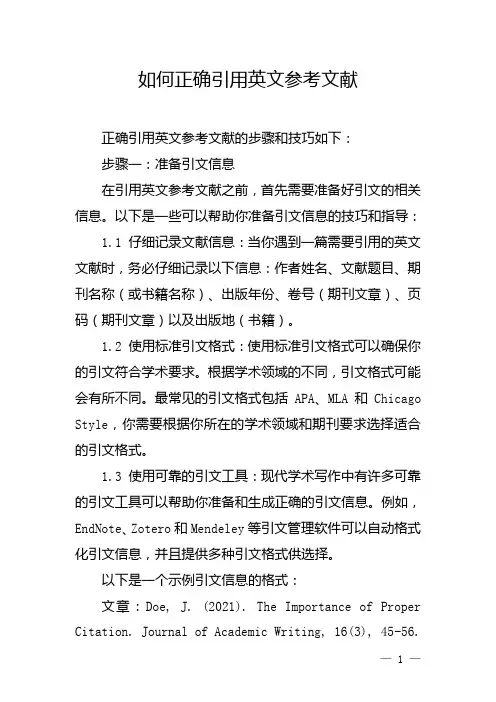
如何正确引用英文参考文献正确引用英文参考文献的步骤和技巧如下:步骤一:准备引文信息在引用英文参考文献之前,首先需要准备好引文的相关信息。
以下是一些可以帮助你准备引文信息的技巧和指导:1.1 仔细记录文献信息:当你遇到一篇需要引用的英文文献时,务必仔细记录以下信息:作者姓名、文献题目、期刊名称(或书籍名称)、出版年份、卷号(期刊文章)、页码(期刊文章)以及出版地(书籍)。
1.2 使用标准引文格式:使用标准引文格式可以确保你的引文符合学术要求。
根据学术领域的不同,引文格式可能会有所不同。
最常见的引文格式包括APA、MLA和Chicago Style,你需要根据你所在的学术领域和期刊要求选择适合的引文格式。
1.3 使用可靠的引文工具:现代学术写作中有许多可靠的引文工具可以帮助你准备和生成正确的引文信息。
例如,EndNote、Zotero和Mendeley等引文管理软件可以自动格式化引文信息,并且提供多种引文格式供选择。
以下是一个示例引文信息的格式:文章:Doe, J. (2021). The Importance of Proper Citation. Journal of Academic Writing, 16(3), 45-56.步骤二:根据引文格式书写引文一旦你准备好引文信息,接下来就要根据所选的引文格式书写引文。
以下是一些可以帮助你正确书写引文的技巧和指导:2.1 注意引文元素的顺序:根据选定的引文格式,确保按照正确的顺序书写作者姓名、文献题目、期刊名称(或书籍名称)、出版年份、卷号(期刊文章)、页码(期刊文章)以及出版地(书籍)等元素。
2.2 使用适当的标点符号:根据引文格式的要求,使用适当的标点符号来分隔不同的引文元素。
例如,APA格式要求在作者姓名和出版年份之间使用圆括号,而MLA格式不需要圆括号。
2.3 注意使用斜体和引用号:根据引文格式的要求,用斜体标记文献题目、期刊名称(或书籍名称)等。
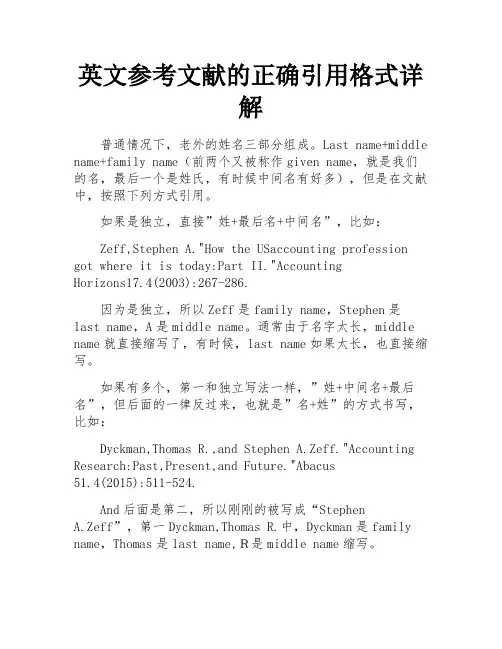
英文参考文献的正确引用格式详解普通情况下,老外的姓名三部分组成。
Last name+middle name+family name(前两个又被称作given name,就是我们的名,最后一个是姓氏,有时候中间名有好多),但是在文献中,按照下列方式引用。
如果是独立,直接”姓+最后名+中间名”,比如:Zeff,Stephen A."How the USaccounting profession got where it is today:Part II."AccountingHorizons17.4(2003):267-286.因为是独立,所以Zeff是family name,Stephen是last name,A是middle name。
通常由于名字太长,middle name就直接缩写了,有时候,last name如果太长,也直接缩写。
如果有多个,第一和独立写法一样,”姓+中间名+最后名”,但后面的一律反过来,也就是”名+姓”的方式书写,比如:Dyckman,Thomas R.,and Stephen A.Zeff."Accounting Research:Past,Present,and Future."Abacus51.4(2015):511-524.And后面是第二,所以刚刚的被写成“StephenA.Zeff”,第一Dyckman,Thomas R.中,Dyckman是family name,Thomas是last name,R是middle name缩写。
如果有更多,除了第一是姓+名,后面的不管and在哪里,一律“名+姓”。
缩写字母后面要加”.”小伙伴们,你们get到了吗?。
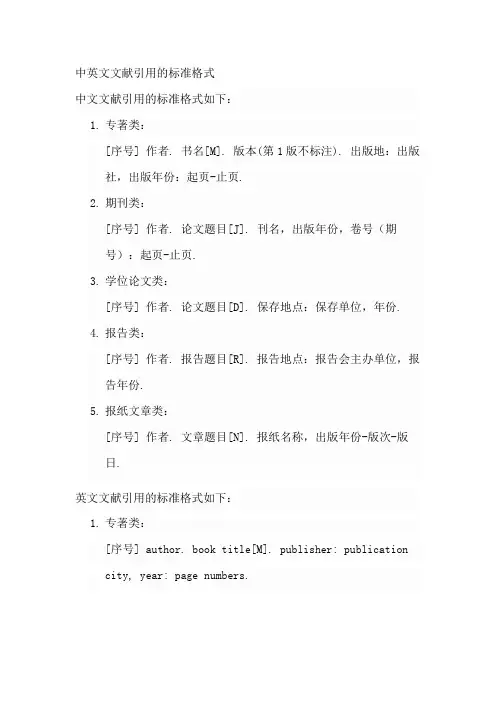
中英文文献引用的标准格式
中文文献引用的标准格式如下:
1.专著类:
[序号] 作者. 书名[M]. 版本(第1版不标注). 出版地:出版社,出版年份:起页-止页.
2.期刊类:
[序号] 作者. 论文题目[J]. 刊名,出版年份,卷号(期
号):起页-止页.
3.学位论文类:
[序号] 作者. 论文题目[D]. 保存地点:保存单位,年份.
4.报告类:
[序号] 作者. 报告题目[R]. 报告地点:报告会主办单位,报告年份.
5.报纸文章类:
[序号] 作者. 文章题目[N]. 报纸名称,出版年份-版次-版
日.
英文文献引用的标准格式如下:
1.专著类:
[序号] author. book title[M]. publisher: publication
city, year: page numbers.
2.期刊类:
[序号] author. article title[J]. journal title,
volume(issue): page numbers.
3.学位论文类:
[序号] author. thesis title[D]. location: institution name, year.
4.报告类:
[序号] author. report title[R]. location: report
organizer, year.
5.报纸文章类:
[序号] author. article title[N]. newspaper name, year-day-month.。
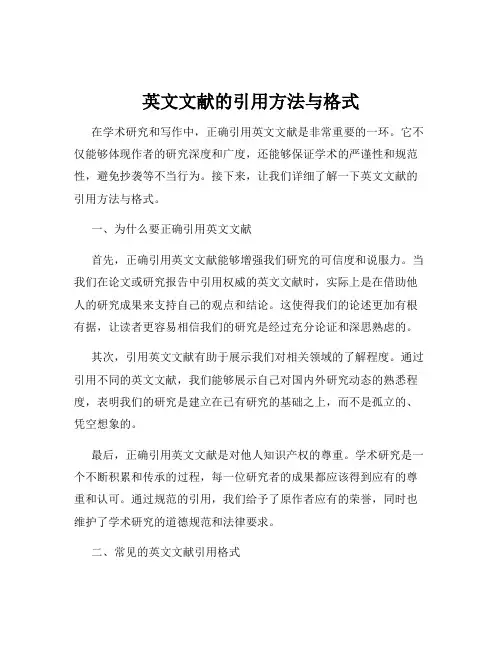
英文文献的引用方法与格式在学术研究和写作中,正确引用英文文献是非常重要的一环。
它不仅能够体现作者的研究深度和广度,还能够保证学术的严谨性和规范性,避免抄袭等不当行为。
接下来,让我们详细了解一下英文文献的引用方法与格式。
一、为什么要正确引用英文文献首先,正确引用英文文献能够增强我们研究的可信度和说服力。
当我们在论文或研究报告中引用权威的英文文献时,实际上是在借助他人的研究成果来支持自己的观点和结论。
这使得我们的论述更加有根有据,让读者更容易相信我们的研究是经过充分论证和深思熟虑的。
其次,引用英文文献有助于展示我们对相关领域的了解程度。
通过引用不同的英文文献,我们能够展示自己对国内外研究动态的熟悉程度,表明我们的研究是建立在已有研究的基础之上,而不是孤立的、凭空想象的。
最后,正确引用英文文献是对他人知识产权的尊重。
学术研究是一个不断积累和传承的过程,每一位研究者的成果都应该得到应有的尊重和认可。
通过规范的引用,我们给予了原作者应有的荣誉,同时也维护了学术研究的道德规范和法律要求。
二、常见的英文文献引用格式1、 APA 格式APA(American Psychological Association)格式是社会科学领域中常用的引用格式。
在 APA 格式中,书籍的引用通常包括作者、出版年份、书名、出版地和出版社。
例如:Smith, J (2018) The History of Psychology New York: Wiley 期刊文章的引用则包括作者、出版年份、文章标题、期刊名称、卷号、期号和页码。
例如:Johnson, M (2020) The Effects of Stress on Learning Journal of Educational Psychology, 112(3),456-478、2、 MLA 格式MLA(Modern Language Association)格式主要用于人文科学领域。
英文文献的引用格式
引用格式是指撰写书面作品时,为了让读者能够更好地获取和验证来源信息,对原文的引用的规定。
1、在书名号内的引文:引文放在美国心理学会(APA)文献造句中括号里,以作者姓氏年份为引述依据,格式例如:(新闻,2008),或者(尼尔森,2009)。
2、在书名号外的引文:书名号外的引文则以作者姓氏年份后,可以紧跟插入的句子,后加引号来表示,格式例如:尼尔森(2009)指出:“…”。
3、网络引用格式:网络引用中,常见的格式有以下几种,如:
(1)网页引用:包括作者姓氏、年份、出版物出版日期及其他需要注明的信息,格式示例:(黄,2008年1月20日);
(2)网络文本引用:除作者姓氏、年份之外,还应该注明文本出处,格式示例:(黄,2008,来自“百度百科”);
(3)电子邮件=引用:引用的内容应该包括作者的姓氏、发送日期以及收件地址,格式示例:张(2008年11月1日,来自
******************)。
以上就是英文文献的引用格式,希望能够帮助到大家,祝大家写作愉快。
英文引文格式英文引文格式是在论文、学术文章和其他研究性文献中引用他人观点或研究成果的标准方法。
正确使用引文格式能够有效地防止抄袭,并且为读者提供进一步了解研究成果的途径。
以下是常见的英文引文格式:1. 直接引用:当直接引用他人观点或语言时,需要在文中引用并在引用后加上作者姓名、年份和页面编号。
例子:According to Smith (2010), 'The Earth revolves around the sun' (p. 23).2. 间接引用:当间接引用他人观点或语言时,需要在文中引用作者姓名和年份,但不需要页面编号。
例子:According to a study by Johnson (2008), a plant-based diet can reduce the risk of heart disease.3. 多个作者:当引用多个作者的观点或研究成果时,需要列出所有作者的姓名,并在最后一个作者的姓名后加上“et al.”。
例子:According to a study by Smith et al. (2015), exercise canimprove mental health.4. 多篇文章:当引用多篇文章时,需要按照字母顺序列出作者姓名,并用分号分隔每个作者。
在每个引用后加上逗号和年份。
例子:Several studies have shown the benefits of meditation (Grossman et al., 2004; Davidson et al., 2003; Tang et al., 2007).5. 电子资源:当引用电子资源时,需要在引用后加上资源的类型和检索日期。
例子:According to the National Institutes of Health (2016), 'most people need between 7 and 9 hours of sleep each night' (online resource, accessed on 10/1/2019).正确使用英文引文格式可以提高论文或文章的质量、可读性和可信度。
引用外文文献的格式英文参考文献引用格式有两种:APA格式和MLA格式。
1、APA格式:APA(American Psychological Association)是一种标明参考来源的格式,主要使用在社会科学领域及其他学术准则中,国内很多期刊也是采用的APA格式。
APA文内注的参考文献格式是:“(作者姓氏,发表年份)”。
APA文末的参考文献目录格式是:Reference List, 必须以姓(Family name)的字母顺序来排列,基本结构为:期刊类:【作者】【发表年份】【文章名】【期刊名】【卷号/期数:起止页码】Smith,J.(2006).The title of the article.The title of Journal,1,101-105。
非期刊类:【作者】【发表年份】【书籍名】【出版地:出版社】Sussan.G.(2002).What computers can't do.New York:Harp&Row。
2、MLA格式:MLA是美国现代语言协会(Modern Language Association)制定的论文指导格式,多用于人文学科(Liberal Arts)。
MLA文内注的基本格式:“(作者姓氏,文献页码)”。
MLA文末的参考文献目录格式:在MLA格式中称为Works Cited,同样是以姓(Family name)的字母顺序来排列,基本结构为:期刊类:【作者】【“文章名”】【期刊名】【卷号或期数】【发表年份】起止页码】Nwezeh,C.E.“The Comparative Approachto Modern African Literature.”Year book of General and ComparativeLiterature 28(1979):22。
非期刊类【作者】【书籍名】【出版地:出版社】【发表年份】Winfield,Richard w in Civil Society.Madison:U of Wisconsin P,1995。
逆天总结英文文献的引用方法与格式-APA格式所谓APA格式是指美国心理学会(American Psychological Association) 所出版的出版手册(PublicationManual) 中,有关投稿该协会旗下所属二十九种期刊时必须遵守的规定而言。
学术界通称为APA格式。
APA引证格式由两部分组成:论文中的文献引用与论文后面的参考文献。
必须注意的是,参考文献部份与文献引用部份息息相关,引用过的文献必须出现在参考文献中,而且参考文献中的每一项文献都被引用过,两者的作者姓氏以及发表年代也必须完全一致。
一、文献引用(Citation in Text)文献引用的目的,一方面是帮助读者进一步直接查阅有关文献的内容,另一方面是尊重与保障他人的知识产权。
文献引用的方式主要有两种,一种是在行文当中直接引用作者姓氏,如:Widdowson (1978)has claimed that native speakers can better understand ungrammatical utteranceswith accurate vocabulary than those with accurate grammar and inaccuratevocabulary. 另一种是直接引用研究的结果或论点,如:Communicative methods have the common goalsof bringing language learners into closer contact with the target language(Stern, 1981). APA文献引用的格式主要有下列几种,分述如下:(一)作者为一个人时例1:Stahl(1983) has demonstrated that an improvement in reading comprehension can beattributed to an increase in vocabulary knowledge. [注:若行文中提到作者姓氏,用此例所示格式引用]例2:Duringthe period of Grammar Translation methodology, bilingual dictionaries becamecommon as reference tools (Kelly, 1969). [注:行文中未提到作者姓氏,用此例所示格式引用;句子本身的标点符号位于括号的后面。
英文文献的参考文献格式英文参考文献的标准格式有哪些呢?第一,期刊(Journal)是最常见的参考文献类型。
它一般依次包括:作者,文章的题目,期刊名称,发表年份,卷号和页码。
譬如:Author 1,A. B.; Author 2, C. D. Title of the article. Abbreviated Journal name Year ,volume ,page range ,DOI or other identifier .Available online :URL(accessed on Dav Month Year).当然,页码也可以由DOI,文章编号(Artice Number)代替。
第二,参考文献如果是书(Book),则一般要列出:作者,书名,出版社,出版社地点(包括城市和国家),年份,页码。
譬如:Dyckman,Thomas R.,and Stephen A.Zeff."Accounting Research:Past,Present,and Future."Abacus 51.4(2015):511-524.第三,而如果引用的是书中的某个章节(Chapter),需要流出的信息有:作者,章节的题目,书名,编辑,出版社,出版社地点(包括城市和国家),年份,卷号,页码。
譬如:Author 1,A. ;Author 2, B. Title of the chapter .Tn Book Title ,2nd ed .;Editor 1, A.,Editor 1, B.,Eds.;Publisher Location ,Country,2007;Volume 3 ,pp.154-196.Author 1,A. ;Author 2, B. Title of the chapter .Tn Book Title ,2nd ed .;Editor 1, A.,Editor 1, B.,Eds.;Publisher Location ,Country,2007;Volume 3 ,pp.154-196.第四,而如果引用的文献是还没有发表的,则需要依次给出以下信息:作者,文章题目,期刊名称和阶段。
英文写作中的引用技巧与规范引用是英文写作中取得他人观点和研究成果的重要方式。
正确使用引用技巧和遵守引用规范可以增加文章的可信度和说服力。
本文将介绍几种常用的引用技巧和规范,以帮助读者提升英文写作的水平。
一、直引法直引法是最常用的引用技巧之一。
当我们希望引用他人原文时,可以使用直引法。
在引用时,需要在引文前后加上双引号,明确标示出原文内容。
“xxx” (作者, 年份, 页码)。
例如,Smith (2010)指出:“英语是世界上最常用的语言之一。
”此处,引文以双引号包裹,作者名字和年份放在引文的括号中。
二、间接引用法间接引用法是引用他人观点或研究成果时,使用自己的语言对其进行解释和概括。
间接引用法常用于对复杂内容进行阐述。
当使用间接引用法时,不需要使用双引号。
例如,根据作者的研究结果,英语的使用率逐年上升(Smith, 2010)。
此处,我们并未直接引用作者的原文,而是用自己的语言对其观点进行了概括。
三、长引用法当引用的内容长度超过40个词时,应使用长引用法。
长引用法要求将引文单独另起一段,使用缩进格式,不需要加上双引号。
引文后面加上作者名字、年份和页码信息。
例如:The research indicates that "English has become a global language, with over 1.5 billion people around the world learning it as a second language" (Smith, 2010, p. 25).四、引用规范在进行英文写作中,除了使用正确的引用技巧外,还需要遵守引用规范。
以下是一些常见的引用规范要求:1.在引文中标注作者名字、年份和页码信息。
这样可以方便读者查找原文,了解引用的来源。
2.在引文后的参考文献中,按照特定格式列出引用的书籍、期刊、网页等信息。
不同学术领域有不同的引用格式要求,例如APA、MLA 等。
英文文献的引用方法与格式-- APA格式所谓APA格式是指美国心理学会(American Psychological Association) 所出版的出版手册(Publication Manual) 中,有关投稿该协会旗下所属二十九种期刊时必须遵守的规定而言。
学术界通称为APA格式。
APA引证格式由两部分组成:论文中的文献引用与论文后面的参考文献。
必须注意的是,参考文献部份与文献引用部份息息相关,引用过的文献必须出现在参考文献中,而且参考文献中的每一项文献都被引用过,两者的作者姓氏以及发表年代也必须完全一致。
一、文献引用(Citation in Text)文献引用的目的,一方面是帮助读者进一步直接查阅有关文献的内容,另一方面是尊重与保障他人的知识产权。
文献引用的方式主要有两种,一种是在行文当中直接引用作者姓氏,如:Widdowson (1978) has claimed that native speakers can better understand ungrammatical utterances with accurate vocabulary than those with accurate grammar and inaccurate vocabulary. 另一种是直接引用研究的结果或论点,如:Communicative methods have the common goals of bringing language learners into closer contact with the target language (Stern, 1981). APA文献引用的格式主要有下列几种,分述如下:(一)作者为一个人时例1:Stahl (1983) has demonstrated that an improvement in reading comprehension can be attributed to an increase in vocabulary knowledge.[注:若行文中提到作者姓氏,用此例所示格式引用]例2:During the period of Grammar Translation methodology, bilingual dictionaries became common as reference tools (Kelly, 1969). [注:行文中未提到作者姓氏,用此例所示格式引用;句子本身的标点符号位于括号的后面。
]例3:…, the ability to use etymology was respected as “one way of discovering truth” (Kelly, 1969, p. 30). [注:若行文中有直接引语,须标明引语在原文中的页码。
如果直接引语跨越两页(或以上),需用“pp.”;如“(Kelly, 1969, pp. 30-31)”]如果直接引语超过40个词,所引用的材料须单列一段,左右两边内缩三到五个字符,不用双引号;用来标注引证的圆括号位于引证材料本身的标点符号后面。
例4:It follows, then, that vocabulary, as a bearer of meaning, is considered by the Natural Approach to be very important to the language acquisition process:Acquisition depends crucially on the input being comprehensible. Andcomprehensibility is dependent directly on the ability to recognize the meaning ofkey elements in the utterance. Thus, acquisition will not take place withoutcomprehension of vocabulary. (Krashen & Terrell, 1983, p.155)[注:此例的前两行是论文作者的叙述,其余是直接引语。
因超过40个词,用此格式。
](二)作者为两人或两人以上时1.作者为两人时,两人的姓氏全列。
例5:Ulijin and Strother (1990) claim that “while a complete conceptual and lexical analysis may be necessary for reading comprehension, a thorough syntactic analysis is not” (p. 38). [注:页码标记在直接引语的后面。
请比较此例与例3的不同。
此次论文写作不采纳:Ulijin and Strother (1990, p. 38) claim that “while …”的引证格式。
]例6:Readers tend to disregard information that seems unimportant, add information that ‘should’ be there, and focus their attention on what, in their opinion, is essential (Steffensen & Joag-Dev, 1984). [注:行文中两人的姓氏用“and”连接(例5),在圆括号内用“&” 连接(此例)。
]2.作者为三至五人时,第一次所有作者均列出,第二次以后只写出第一位作者,并加“et al.”。
例7:According to Ostny, Vandecasteele, Deville, and Kelly (1987), indispensable conditions for reading in L2 are underst anding the text’s words and the knowledge of its subject matter. [注:行文中提到作者,按此例引证。
]例8:Indispensable conditions for reading in L2 are understanding the text’s words and the knowledge of its subject matter (Ostny, Vandecasteele, Deville, & Kelly, 1987).[注:行文中没有提到作者,按此例引证。
]例9:According to Ostny et al. (1987), indispensable conditions for reading in L2 are understanding the text’s words and the knowledge of its subject matter.[注:第二次引证同一著作,按此例格式引证。
]3.作者为六人以上时,仅列第一位作者并加“et al.”,但在参考文献中要列出所有姓名。
(三)作者为组织、团体、或单位时1.易产生混淆的单位、每次均用全名。
2.在不产生误会的情况下,第二次以后可用缩写,但在参考文献中一律要写出全名。
例10:Proficiency level is based on the ACTEF scale developed by the American Council on the Teaching of Foreign Languages (1980). [注:此例中的“the American Council on the Teaching of Foreign Langua ges”为一团体。
](四)未标明作者(如法令、报纸社论)时1.未标明作者的著作,使用著作名的前二、三个词汇(忽略冠词)作为引证标注。
每个词汇都需大写,且用斜体。
例11:There are certain exceptions in the case of comprehension tests, including the EdinburghReading Tests (1973).[注:在此例中,书名“Edinburgh Reading Tests”作为引证标注。
]2、未标明作者的文章,把引用文章的篇名或章名当作作者并加双引号。
例12:on free care (“Study Finds,” 1982)[注:在此例中,章名“Study Finds”作为作者用做引证标注。
]二、参考文献(References)参考文献中的条目先英文后中文;英文部分按作者姓氏的英文字母顺序排列;中文部分按作者姓氏的拼音顺序排列。
参考文献中不要用“1、2、3 ...”一类的序号标记。
下面是学术论文中各种常用的参考文献的撰写格式。
(一)书籍1.未标明作者或编者时Merriam-Webster’s co llegiate dictionary(10th ed.). (1993). Springfield, MA: Merriam Webster. [注:书名用斜体,只有第一个词的首字母大写,其它(专有名词除外)均为小写;下同。
“Springfield, MA”为出版地点,Merriam Webster为出版商。
]2.作者为一人时Baddeley, A. D. (1999). Essentials of human memory. Hove, England: Psychology Press. [注:作者的姓与名须倒置,即:姓在前,名在后。
]3.作者为两人时Beck, C. A. J., & Sales, B. D. (2001). Family mediation: Facts, myths, and future prospects.Washington, DC: American Psychological Association.[注:两个作者的姓与名都倒置,二个作者用“&”连接。
书名中冒号后的第一个词“Facts”首字母大写,这是因为副标题的第一个词的首字母须大写。
如果条目跨行,第一行顶格,第二行内缩三至五个字符,如此例所示。
]4.作者为一团体或组织Australian Bureau of Statistics. (1991). Estimated resident population by age and sex in statistical local areas, New South Wales, June 1990(No. 3209.1). Canberra, Australian Capital Territory: Author.(二)文集Gibbs, J. T., & Huang, L. N. (Eds.). (1991). Children of color: Psychological interventions withminority youth. San Francisco: Jossey-Bass.[注:在文集编者姓名后加“(Eds.)”。